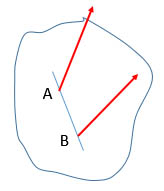A rigid body is defined as a collection of particles in which distance between each pair of particles remains constant.
I was taught that the motion of any one particle of the rigid body with respect to any other particle of the same rigid body is circular. If distance between two particles is constant and both of them are on a rotating rigid body why would the motion of one particles be circular with respect to other,it should be at rest right?
The question I want to ask ,in more detail; now, is:
Let's say that earth is revolving around sun ,without any rotation about its own axis and if we look at earth from sun's frame of reference,earth would appear to be revolving around us with one face of it always towards us.
Now, if we look at sun from earth's frame of reference,how would it look?
Would sun appear to be revolving around us? if it is so, then it is wrong right ? because if sun is revolving around earth then from earth's frame the back side of earth also gets sunlight ,which should not happen.
If sun doesn't revolve around us then what would happen?
Consider a rigid body now
Let's say that the below rigid body rotates about its geometrical centre about an axis perpendicular to the paper
consider two points A and B(some random points) on the rigid body and now join the points A and B
As the body rotates the line AB also rotates about the same axis
Now,how would the motion of B look from A? and how would the motion of geometric center look from A?
- let's suppose that A is earth and B is sun,if you say that B follows circular path about A then you mean that sun follows circular path about earth then the sunlight should fall on earth's back also,but that shouldn't happen right? so how does this happen?
PLEASE TRY TO EXPLAIN THE PROBLEM USING THE SUN AND EARTH METHOD

